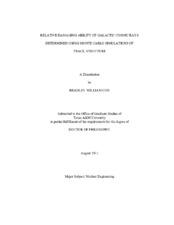| dc.description.abstract | The energy deposition characteristics of heavy ions vary substantially compared to those of photons. Many radiation biology studies have compared the damaging effects of different types of radiation to establish relative biological effectiveness among them. These studies are dependent on cell type, biological endpoint, radiation type, dose, and dose rate. The radiation field found in space is much more complicated than that simulated in most experiments, both from a point of dose-rate as well as the highly mixed field of radiative particles encompassing a broad spectrum of energies. To establish better estimates for radiation risks on long-term, deep space missions, the damaging ability of heavy ions requires further understanding. Track structure studies provide significant details about the spatial distribution of energy deposition events in and around the sensitive targets of a mammalian cell. The damage imparted by one heavy ion relative to another can be established by modeling the track structures of ions that make up the galactic cosmic ray (GCR) spectrum and emphasizing biologically relevant target geometries.
This research was undertaken to provide a better understanding of the damaging ability of GCR at the cellular level. By comparing ions with equal stopping power values, the differences in track structure will illuminate variations in cell particle traversals and ionization density within cell nuclei. For a cellular target, increased particle traversals, along with increased ionization density, are key identifiers for increased damaging ability.
Performing Monte Carlo simulations with the computer code, FLUKA, this research will provide cellular dosimetry data and detail the track structure of the ions. As shown in radiobiology studies, increased ionizations within a cell nucleus generally lead to increased DNA breaks and increased free radical production, resulting in increased carcinogenesis and cell death. The spatial distribution of dose surrounding ions tracks are compared for inter- and intracellular regions. A comparison can be made for many different ions based upon dose and particle fluence across those different regions to predict relative damaging ability. This information can be used to improve estimates for radiation quality and dose equivalent from the space radiation environment. | en |


